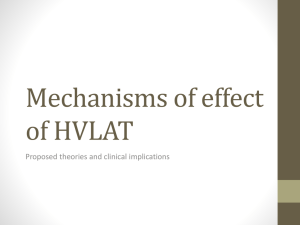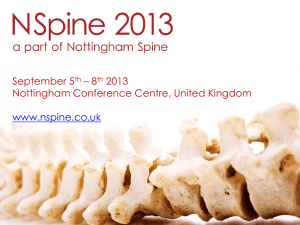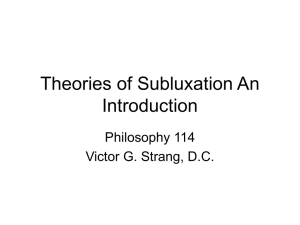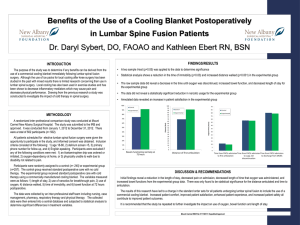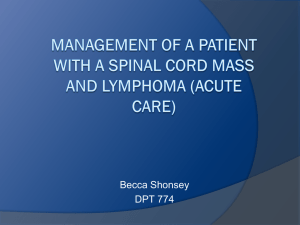Spinal Infections
advertisement
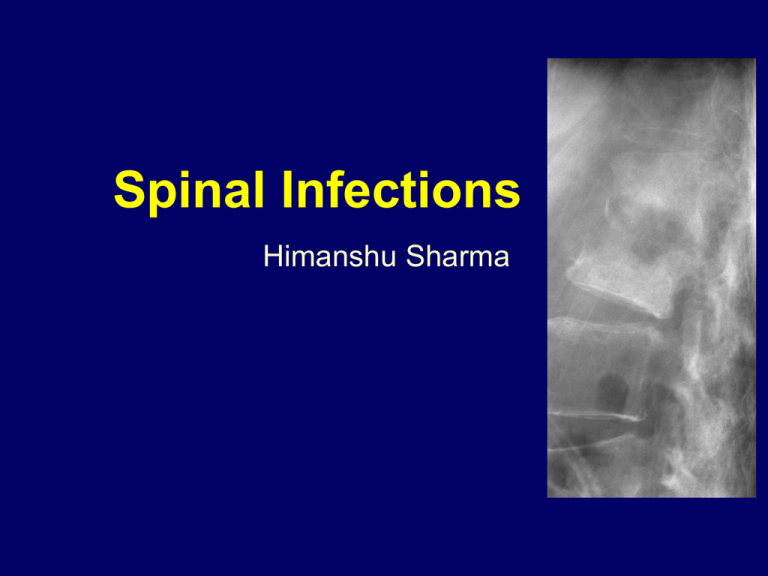
Spinal Infections Himanshu Sharma Spinal Infections Objectives • Epidemiology • Pathology • Clinical features • Management • Prognosis Spinal Infections Epidemiology • 2 - 4% all cases of “osteomyelitis” • Rare: 1 in 250,000/yr but rising incidence • Post-op discitis = 2-3% • Pre-antibiotic mortality = 25-70% • Delayed diagnosis common (50%+ > 3/12) Spinal Infections Levels Spondylodiscitis / facet disease • Lumbar (59%) • Thoracic (33%) • Cervical (8%) Epidural abscess (in 7%) • Cervical • Thoracic • Lumbar (6-18%) anterior Spinal Infections Risk Factors • Peak incidence 7th decade • Concurrent illness/infection Diabetes Obesity Immunosuppressed Malnutrition Steroid therapy Irradiation UTI • Invasive procedures/ trauma • Smoking Spinal Infections Pathology (1) • Organisms S aureus 30 -50% cases Gram-negatives – UTI, Chest, Skin ulcers Opportunistic in immune paresis IVDA • Route of spread Haematogenous Direct extension Post-operative Spinal Infections Pathology (2) • Vertebral metaphyses (end plate region) = end-arteriole blood supply (filter) Septic emboli • Direct spread from implantation Secondary spread to discs, paraspinal tissues and spaces Spinal Infections Clinical Features • Pain and focal tenderness 90% • Fever 61% • Root symptoms/signs 60% • Abnormal neurology 20% Also: deformity, muscle spasms, meningism, sinus, and unexplained septicaemia Investigations • • • • • • FBC ESR CRP Blood & Urine cultures Nutritional status Biopsy Spinal Infections Diagnosis • Lab tests White cell count 40-50% ESR / CRP 80-90% Positive Blood Culture 20-25% • Imaging • Biopsy Spinal Infections Plain radiological findings •Vertebral metaphyseal blurring (osteolysis) •Loss of disc height •Endplate blurring •Subchondral reactive bone formation •Bone destruction (and deformity) •Soft-tissue shadows e.g.psoas abscess Pyogenic discitis/osteomyelitis Bad disc = Good news Spinal Infections Imaging Studies - Isotopes • Detect earlier than plain films • High sensitivity / specificity e.g. gallium + Tc = 95% accurate • Little structural information • False negatives in neutropenics (gallium) • False negatives in bone infarction (Tc) Pyogenic spinal infections imaging studies - CT • delineate bony margins / involvement • soft-tissue invasion • poor for outlining neural elements • risk of spread if combine with myelography, but can obtain CSF • 3D/MPR useful for pre-op planning of reconstruction Spinal Infections Differential Diagnosis • Granulomatous disease • Metastases/Myeloma • Degenerative disease • Osteoporosis • Local Scheuermann’s • Spondyloarthropathies > 95% accuracy T2= signal T1= signal Ring enhancement Spinal Infections Biopsy Biopsy (for identification of the causative organism) • Closed needle biopsy (guided) – 68 - 86% accuracy (false negative 30%) • Open biopsy – > 80% accurate (false negative 14%) • Special lab techniques (DNA PCR, etc) Biopsy principles • Biopsy material should be sent to microbiology for gram stain & acid-fast stain, aerobic, anaerobic, fungal and mycobacterial cultures and for histopathological examination. Spinal Infections Treatment Goals • Establish diagnosis • Clear infection and prevent recurrence • Pain relief • Protect / restore neurological function • Maintain / restore spine stability Changed Battlefield • Territory – Patients • Weapons – Antibiotics –Surgery • Enemy – Microbiology Territory - changed • Patient • • • • • • Population Greying Type 2 DM Cancer Steroids HIV Drug Abuse • Iatrogenic Immunosuppression Transplants Dialysis Enemy - changed • More Resistant Strains of Bacteria • Hospital Acquired Infection • More previously unsuspected causes Weapons • Antimicrobials • Type and Scope of Surgery Why is it important? • Consequence of Inappropriate Management • Multiple Surgery • Pain • Paralysis • Death • Financial Cost • Causes of Inappropriate Management • Lack of awareness • Empirical Antibiotics • Inappropriate /Inadequate Surgery Spinal Infections Treatment (1) Antibiotics – sensitivities – adequate dose (iv then oral) – ensure MBC reached – adequate duration (> 6 weeks) – monitor response (clinical/ indices/ imaging) – toxicity profile and monitoring Spinal Infections Treatment (2) Immobilisation – bed rest – moulded orthoses (low thoracic / lumbar) – halo-vest or orthosis (cervical / high thoracic) 9/12 Pyogenic spinal infections
